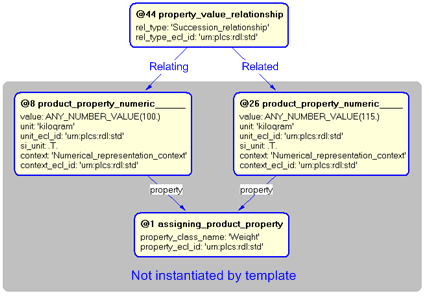| Template:— property_value_relationship (prp_rel) |
Date: 2008/01/22 08:39:36
Revision: 1.19
|
This section specifies the template property_value_relationship.
NOTE
An explanation of a template and the associated instantiation path is
provided in the
Template overview
section.
This template describes how to establish a relationship between property value
representations.
The EXPRESS-G diagram in
Figure
1
shows the templates and EXPRESS entities that are required
to represent the template
"property_value_relationship".
The text highlighted in blue shows the template parameters.
Figure 1 — An EXPRESS-G representation of the Information model for
property_value_relationship
The graphic for the template to be used in other EXPRESS-G diagrams
is shown in Figure
2
below.
Figure 2 — The graphical representation of property_value_relationship template
The following input parameters are defined for this template:
Type of relation between property value representations.
The following classes and their sub-classes can be used:
The identifier of the
External_class_library storing the
definition of the class referenced by the parameter @rel_type.
The earlier, or preceding, representation value of the property,
represented by a (subtype of)
Representation.
The later, or succeeding, representation value of the property, represented
by a (subtype of)
Representation.
The following reference parameters are defined for this template:
%^target = $property_value_relationship.rep_rel%
The instantiation path shown below specifies the entities that are to be
instantiated by the template.
The following entities are instantiated with attributes as specified:
The instance diagram in Figure
3
shows an example of the EXPRESS entities and templates that are instantiated by the template:
/property_value_relationship(rel_type='Succession_relationship', rel_type_ecl_id='urn:plcs:rdl:std', relating='#8', related='#26')/
(an illustration of the consolidated property_value_relationship template is shown in
Figure
4 below.)
Figure 3 — Entities instantiated by property_value_relationship template
The instance diagram in
Figure
4
shows the graphic symbol for the template that is to be
used in other instance diagrams. The example template is:
/property_value_relationship(rel_type='Succession_relationship', rel_type_ecl_id='urn:plcs:rdl:std', relating='#8', related='#26')/
Note that the
assigning_reference_data
template is used in the diagram.
Namely:
/assigning_reference_data(items='#46', class_name='Succession_relationship', ecl_id='urn:plcs:rdl:std')/
Figure 4 — Instantiation of property_value_relationship template
Characterizations
No common characterizations of the template
property_value_relationship
have been identified. However, the ISO 10303-239 EXPRESS model
may enable other assignments to the entities instantiated by the template.




